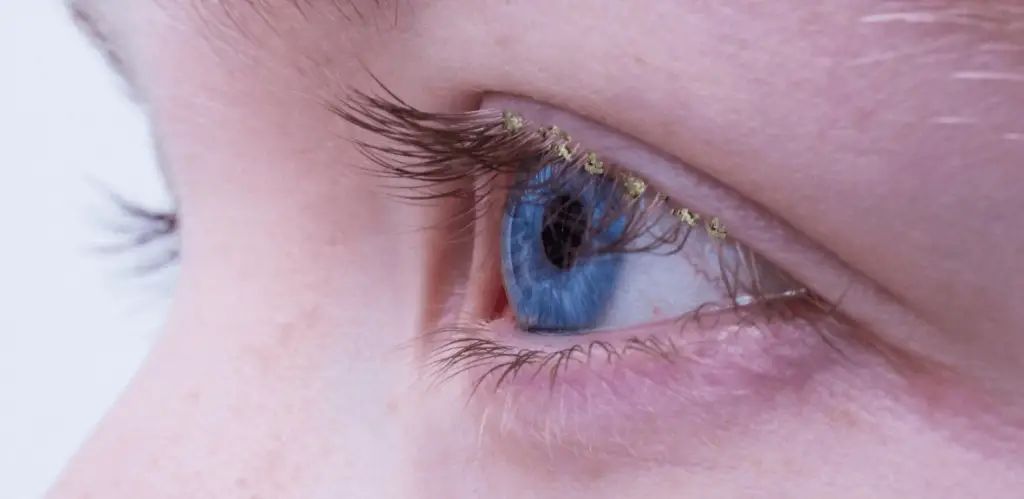Blepharitis is an inflammation of the eyelids whose symptoms include redness of the edge of the eyelid, soreness, itching, crusting, a build-up of dandruff-like scales and a sensation of something in your eye. In some cases, the eye becomes red and inflamed too (conjunctivitis), and the eye lashes may become misaligned so they rub against the eye which is extremely painful and can lead to ulceration.
Quick links: These are the products I recommend for blepharitis from Amazon.co.uk and Amazon.com.
What causes blepharitis?
The exact cause of blepharitis is not fully understood, but it can accompany rosacea – a skin condition associated with facial flushing and redness. Rosacea has been linked with an infection of oil glands, possibly with bacteria or with a skin mite, Demodex folliculorum.
Two distinct Demodex species have now been confirmed as causing some cases of blepharitis – Demodex folliculorum and Demodex brevis. These tiny parasites are found in the eye lash follicles of as many as 84% of people over the age of 60, and 100% of those older than 70 years. As not everyone with these mits has blepharitis, it’s thought that immune reactions to their presence are involved. Another possibility is that some Demodex mites cause blepharitis due to the bacteria that stick to their surface, such as Streptococci and Staphylococci, which in turn release ‘super antigens’ that trigger inflammation. Stress can also trigger a flare-up of blepharitis, as it reduces immunity and increases allergic tendencies.
Although having a skin mite infestation within your eye lashes may sound horrifying, don’t panic – they are easily treated as described below.
Blepharitis can also result form an allergic reaction to cosmetics, face creams, perfume, shampoo or even nail varnish which irritates the eyes when you bring your hands up to your face.
Medical advice for blepharitis
If your eye itself is red and sore (conjunctivitis) it’s important to seek medical advice to find out the cause. If just your lid margins are red and crusty, however, you may find that home treatments can solve the problem. Even so, it’s always a good idea to see a doctor or optometrist to have the diagnosis confirmed. An optometrist can also use a slit lamp microscope to examine the eye and confirm typical signs of Demodex mite infestation (eg cylindrical dandruff at the root of the eyelashes).
If you wear contact lenses, stop using them and see your optometrist in case you have an allergy to the contact lens solutions, and to rule out any infection.
Blepharitis treatment
The traditional blepharitis treatment is to use a baby shampoo to cleanse the eyelids every day. However, researchers have found that using a daily lid scrub containing 50% diluted tea tree oil, plus massaging the lid with a 5% tea tree oil ointment cures blepharitis more effectively than baby shampoo. Don’t make up your own solutions, however, in case you irritate your eyes; use the recommended tea tree wipes below.
The study showed that using tea tree oils products dramatically improved eyelid inflammation and symptoms and, within 4 weeks, almost all patients were cured of Demodex infestation. Not only does tea tree oil cleanse away the typical mite ‘dandruff’ but it also acts as a repellent, stimulating embedded mites to migrate out of the eye lash follicle onto the skin for easier removal. They also found that using a tea tree oil cleansing wipe directly killed the mites, and that the 5% tea tree oil ointment interrupted the mite’s life cycle by preventing mating.
You can find Optase Tea Tree Oil Lid Wipes, which are preservative free, at Boots and Amazon.co.uk, and Cliradex tea tree oil based wipes on Amazon.co.uk and Amazon.com.
If you prefer a non-tea tree oil range of products, the leading range is Blephagel, Blephasol, and Blephaclean wipes. These are available from Amazon.co.uk and Amazon.com.
Boots also has a unique Blepharitis Eye Lid Foam which helps to lift up and remove oil, debris and other contaminants from your lashes.
Eye drops for blepharitis
If your eyelids are dry, or your eyes feel dry and irritated, spraying on Optase Eye Spray can help. Specially formulated for irritated eyes and eyelids, it contains Sea Buckthorn oil, a traditional treatment for dry eyes (when taken by mouth). The eyelid spray soothes irritation, and strengthens the tear film and lipid layer of the eyes. Optase Eye Spray is available from Boots and from Amazon.co.uk.
Moist heat mask for blepharitis
Optase Moist Heat Mask soothes the eyes and also helps to eradicate any infection. The mask is designed for use with dry eyes or blepharitis. Pop the mask in the microwave to warm for 25 seconds, then sit back with it placed over your eyes for 10 minutes.
Available from Boots and from Amazon.co.uk.
Blepharitis and allergy
If eyelid cleansing doesn’t quickly resolve the problem, then you may have an allergy.
Stop using your usual face cleaning products, creams and cosmetics. Once symptoms resolve, gradually re-introduce products, one at a time every three or four days, to see if any retrigger the problem. If so, you could have an allergy to one of the ingredients within that product.
Avoid rubbing eyes when preparing any foods, but especially chillies. Pungent onions can cause eye watering – put chopped pieces in a bowl of water to minimise this. You can also wear goggles during preparation.
Blepharitis supplements
Evening primrose oil can help to reduce dry eyes.
Bilberry extracts help to stabilize tear production.
Sea buckthorn oil is a traditional oral treatment for dry eyes.
Foods that can help blepharitis
Increase your intake of oily fish, such as salmon, mackerel, herrings, sardines or take a high strength, omega-3 fish oil supplement. Omega 3 oils help to reduce inflammation. Other good sources include flaxseed, nuts (especially walnuts), and seeds (especially pumpkin seeds and flax seeds). Drizzle flaxseed or pumpkinseed oil over vegetables and salads.
At the same time, cut back on processed foods, sunflower oil, safflower oil and corn oil, as these supply omega-6s which can promote inflammation.
Avocado and macadamia nuts, plus their oils, supply monounsaturated fats that are beneficial for dry eyes.
Drink plenty of fluids – water, juices and herbal teas are ideal.
Cupping for sore eyes
I’m not sure why this trick works, but it is really soothing for sore eyes. Sit back with your eyes closed and place the cupped palms of your hands over your eyes for a few minutes. Your eyes will feel remarkably refreshed when you move your hands away.
Have you found a way to solve your blepharitis? Please share your experience below.

